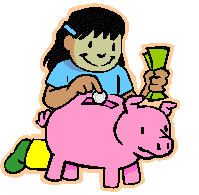It is never too early to learn about the value of money and how to budget and save. The earlier you can teach a child about earning interest versus paying it, the better prepared they will be to manage their own money.

Also, here is some more information on teaching money skills, and some helpful money worksheets, lessons, and lesson plans.
Learning the Value of Money
5-10 years Old
Young children love to collect and save pennies. They rarely learn to understand their value until they get toward the older end of this age range. To help them out, families can talk about the family’s budget together. This doesn’t mean worrying children about the bills or making them feel guilty for costing you so much. What it does mean is explaining that there is a certain amount of money that comes into the household and that there are some expenses, such as food, utilities and clothing that must be paid for from that money.
There is also a set amount (you don’t need to say how much) that must be saved for emergencies and future expenses. By setting up a “family piggy bank” you can illustrate what it is to save for something fun for the whole family.
Children who get an allowance should have it explained to them what they will be required to use it for. You can teach children to always put 10% or more of their allowance in savings, another amount toward a charity, and then the rest is for their spending. Let the children see when they earn interest on their bank accounts too.
11-15 Years Old
Children in this age group may have more opportunities to earn some money. If they are asked to feed the neighbor’s cat and earn $10, teach them again to put a percentage away into savings. This is also a good age to take the child to the bank and open their own savings account.
If the habit of putting money into savings each time they are paid is established early then it will be more likely to become a lifelong way of managing money. Allowances may or may not be tied into chores, but it is important that children this age understand the importance of “earning” their incomes just like Mom and Dad do. The allowance can also be approached as their share of the family’s income. Again it should be explained what they must buy for themselves from this income – music CDs, movie tickets, extra unnecessary clothing, etc.
16 and Older
Many teens have part-time jobs and can really understand what it means to earn a living. They will also be introduced to the concept of paying taxes. This is a good time to teach them to manage a checking account and ATM card. They can also be taught to plan ahead for major expenses such as their first car or education. Teens can become more responsible for buying some of their own clothes and other necessities. It will help them appreciate how much things cost and perhaps take better care of their belongings.
No matter the age of your children, they can be part of a family meeting to decide how some of the discretionary income is to be spent. Having a part in the decision making will help them understand the value of money and that there are often limits on spending so some purchases must be deferred.
Next, see our teaching money skills page for more information on teaching money skills.
Money on step.